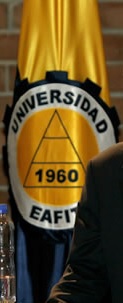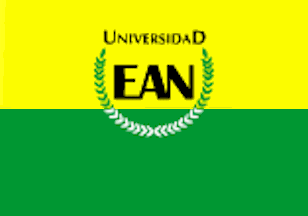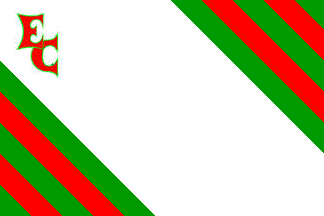 image by Eugene Ipavec, 4 September 2006
image by Eugene Ipavec, 4 September 2006
Last modified: 2025-01-11 by daniel rentería
Keywords: education |
Links: FOTW homepage |
search |
disclaimer and copyright |
write us |
mirrors
See Also:
 image by Eugene Ipavec, 4 September 2006
image by Eugene Ipavec, 4 September 2006
 image from eafit.edu.co
image from eafit.edu.co
3.jpg) image from youtube.com
image from youtube.com
The Colombian University "Universidad EAFIT" Universidad EAFIT www.eafit.edu.co
- This institution was established in 1960 by entrepreneurs of
the city of Medellin called ANDI
(Asociación Nacional de Industriales - National Industry
Asocaition, www.andi.com.co)
with the help of a American University. EAFIT stands for Escuela
de Administración y Finanzas e Instituto Tecnológico
(Administration and Finance School and Technology Institute). The
colors of the flag were taken from this American University. The
cog wheel on the Coat of Arms has twelve cogs. They stand for the
twelve Engineering Programs that were established. The pyramid is
a traditional symbol for Administration, or a better business
term: Management, introduced by Max Weber. And inside the
foundation date, 1960.
Source: Graduation photographs taken back in 2004 by the
company Foto Grisales, located in Medellín
E.R., 4 September 2006
Max Weber, together with Emile Durkheim, is considered one of
the founders of modern sociology.
Ron Lahav, 22 February 2007
EAFIT University commemorated its 50 anniversary yesterday (http://www.eafit.edu.co/50/index.php).
During the celebration of this date, a speech by the current Director of the
institution, one can see a
picture which shows a variant
flag of EAFIT University on the left and the variant with
coat of arms of the flag of the Department of
Antioquia.
Esteban Rivera, 5 May 2010
This past weekend EAFIT University celebrated its 50th anniversary (
http://www2.eafit.edu.co/50/index.php and
http://www.eafit.edu.co/alcampus
), and I got the chance to see a
variant of the reported flag. It is the same color scheme (yellow over blue),
the only thing different, is the
alternate logo.
This
flag can be seen also in a speech given by U.S. Under Secretary of State
James Steinberg, held at this University.
Sources:
http://www.eafit.edu.co/agencia-noticias/historico-noticias/2010/octubre/Paginas/cooperacion-contra-drogas-continuara-colombia-estados-unidos-eafit.aspx
(EAFIT University news report)
and http://www.cmi.com.co/?nt=53301
(CM& tv news).
Esteban Rivera, 26 October 2010
The University was formally established on May 4 with the founding document and classes started officially on August 16 (other sources mention August 17), 1960 as "Escuela de Administración y Finanzas" (EAF)
(Business and Finance School). However it traces its origins back to 1958-1959 when 18 (other sources mention 17) Business Managers adherent to ANDI
saw the need to establish a Business School in the city. In February 1962 the "Instituto Tecnológico"
[Technological Institution] starts classes also, envisioned since April 1961 when it was thought to become either a "polytechnic" or "institute of technology"
thanks to a grant from the Whirlpool Foundation (official website: whirlpoolcorp.com), the US government "Tools for Freedom"
program, and the Benton Harbor Community College and Technical Institute (today the Lake Michigan College), as well as support by U.S.
company Burlington Mills (later on Burlington Industries, acquired by WL Ross & Co which merged Cone Mills Corporation to form the International Textile Group, sold to Platinum Equity,
LLC and in 2019 following Integration with American & Efird, Burlington (official website: burlingtonfabrics.com), Cone Denim, Gütermann, and Safety Components, it became
Elevate Textiles (official website: elevatetextiles.com), the two merging later on. In 1973 it is formally denominated as EAFIT.
Sources: [1],
[2], [3],
4], [6], [7] and
[8].
In the introduction of the background of this institution, the
following is mentioned: "... with the help of a(n) American
University." It turns out, this University is actually Syracuse University which
helped set off EAFIT in its beginnings, especially from 1962 until
1969. Another U.S. University linked to EAFIT in the beginning was
Drexel Institute (now Drexel University), all supporting
with Professors, advisory, scholarships and bibliography.
Sources: [1],
and [2].
It currently has presence in Bogotá, Medellín, Pereira and Rionegro.
Esteban Rivera, 24 November 2024
2.gif) image from eafit.edu.co
image from eafit.edu.co
.gif) image by Eugene Ipavec, 4 September 2006
image by Eugene Ipavec, 4 September 2006
1.jpg) image from youtube.com
image from youtube.com
0.jpg) image from youtube.com
image from youtube.com
 image by Randy Young, 25 March 2018
image by Randy Young, 25 March 2018
I spotted the flag of Universidad EAN (English: EAN University). EAN (Escuela
de Administración de Negocios, in English Business Administration School) is a
private University established on August 10, 1967 although formally established
on October 11, 1968 in Bogotá and formally became a University through
Resolution No. 2470 (of the Ministry of Education) of May 30, 2006.
Sources:
https://universidadean.edu.co/es/la-universidad/quienes-somos/historia-de-la-universidad-ean,
https://universidadean.edu.co/sites/default/files/institucion/reglamentos/Estatutos_Universidad_EAN.pdf
and
https://es.wikipedia.org/wiki/Universidad_EAN.
The flag is a
horizontal flag, equally divided into to horizontal stripes (top being yellow
and bottom being green) with the logo (https://universidadean.edu.co/sites/default/files/ean_t_0.png)
in the middle, as seen here:
https://universidadean.edu.co/...miniatura-web.jpg (source:
https://universidadean.edu.co/es/noticias/el-presidente-es-el-primer-educador-de-un-pais-fajardo).
Additional images of the flag are seen all throughout this video (https://www.youtube.com/watch?v=lQVZEUxcstM)
and also here (second flag from left to right):
https://universidadean.edu.co/sites/default/files/la-universidad/instalaciones/sede-av-chile.jpg
(source:
https://universidadean.edu.co/es/la-universidad/instalaciones). The yellow
color represents and the green color represents wisdom, peace and glory.
The logo features the University's name in black, surrounded by a green laurel
wreath. The colors in CMYK code are:
- Black: K:100
- Green: C:83 M:24 Y:
54 K: 8
The flag was adopted by Acuerdo (Agreement) No. 56, of November
20, 1984 (source:
https://universidadean.edu.co/sites/default/files/institucion/manuales/manual_imagen_institucional_19.pdf).
Since both the Universidad EAN and EAN are copyrighted, here's some
additional information on Institutional image (https://universidadean.edu.co/es/la-universidad/quienes-somos/imagen-institucional)
and use of corporate identity manual (https://universidadean.edu.co/sites/default/files/institucion/manuales/usos_correctos_de_la_marca_u.ean.pdf)
A GIF version of the flag is seen here:
https://userscontent2.emaze.com/images/8f65f2f2-58a2-4ea5-aa2c-5083075fe3c9/a39c80cf-bbe2-475d-a6f3-a2e218d881a9.png
(source:
https://www.emaze.com/@ALLWRIWW/Presentaci%C3%B3n-Guia-2)
For
additional information go to EAN (official websites): http://www.ean.edu.co/ and
https://universidadean.edu.co/
Esteban Rivera, 23 March 2018
 image by Ivan Sache, 08 June 2018
image by Ivan Sache, 08 June 2018
Universidad ECCI was established, as Escuela Colombiana de Carreras
Intermedias, by Resolution No. 15,572, enacted on 25 October 1978 by the
Ministry of National Education. Universidad ECCI was recognized by Resolution No.
13,370, enacted on 19 August 2014 by the Ministry of National Education.
Universidad ECCI is composed of 6 Faculties: Basic Sciences, Health Sciences,
Humanities, Arts, Engineering, and Economic and Administrative Sciences.
Source: University website
The flag of Universidad ECCI is white with a blue-yellow border, except along
the hoist, and the university's coat of arms.
The coat of arms of ECCI includes three mounts representing the three ranges that
surround the town; the sun, representing hope that enlightens the country; the
book taken from the university's logo; the university's name and year of
foundation.
The logo of ECCI features a book, as a symbol of knowledge. The book's cover is
quartered by a white cross, as a symbol of Christian faith, in four colored
quarters with the letters "E" (on blue), "C" (on red), "C" (on yellow), and "I"
(on blue).
Source:
University website
Ivan Sache, 08 June 2018
 image by Ivan Sache, 5 February 2009
image by Ivan Sache, 5 February 2009
"Colegio 'Eduardo Carranza'" was created in
Villavicienco, Department of Meta, on 2 December 1985 (Decree No.
022).
The institute is named after the poet Januario Eduardo Carranza
Fernández (1913-1985). Professor and diplomat, Carranza was a
precursor of the "Piedra y Cileo" (Stone and Sky)
movement; he translated into Spanish poems by Verlaine, Éluard
and Apollinaire.
The flag of the institute, as shown graphically on the website of the
institute, is white with five green-red-green-red-green,
diagonal stripes in the lower left and upper right corners and
the monogram of the institute, made of the red letters
"EC" outlined in green, in the upper left corner.
The monogram also appears on the emblem of the institute, placed
on a white triangle with a green border.
Ivan Sache, 5 February 2009
 image by Ivan Sache, 06 August 2014
image by Ivan Sache, 06 August 2014
Institución Educativa Eduardo Fernández Botero was established in Amalfi
(Antioquia Department) by National Resolution No. 5,547 of 15 October 1960, as
Colegio Sagrada Familia. The current name of the institute was adopted by
Departmental Resolution No. 3,934 of 22 November 1989. The institute is named
for the lawyer Eduardo Fernández Botero (1905-1974), elected Mayor of Medellín
in 1946.
The flag of the institute is horizontally divided green-white-red.
Photos - Institute's website
http://eduardofernandez.edu.co/web/wp-content/uploads/2012/01/3.jpg
http://eduardofernandez.edu.co/web/wp-content/uploads/2012/01/11.jpg
http://eduardofernandez.edu.co/web/wp-content/uploads/2012/01/14.jpg
Ivan Sache, 06 August 2014
"Colegio 'Eduardo Santos'" is located at Bogotá.
The flag of the institute, according to a photo shown on the website
of the institute, is horizontally divided dark red-silver
with the emblem of the institute in the middle.
he circular emblem of the institute shows on a white background
two hands holding a tree and two grain heads - or rice panicles,
surrounded by the black writing "CENTRO EDUCATIVO
DISTRITAL" (top) / "EDUARDO SANTOS" (bottom). The
emblem is bordered, from outside to inside, by a thin red ring, a
thicker ring horizontally divided dark red-silver, like the flag,
and charged with the writing "REPUBLICA DE COLOMBIA"
(top, white) / "CREADO IN NOVIEMBRE DE 1996" (bottom,
black), and a yellow thinner ring.
Ivan Sache, 16 January 2009
 image by Ivan Sache, 11 September 2022
image by Ivan Sache, 11 September 2022
I.E. Eduardo Santos is based in Neiva (department of Huila).
The flag
of I.E. Eduardo Santos is green with a yellow descending diagonal and another
yellow stripe running from the flag's center to the upper joist. The flag in use
is charged in the center with the school's coat of arms placed on a white disc.
https://ieduardosantosneiva.edu.co/simbolos-institucionales - School's
website
Ivan Sache, 11 September 2022
 image by Ivan Sache, 03 September 2017
image by Ivan Sache, 03 September 2017
Colegio Ekklesia is a Christian educational institute based in Cali. The
Bolivian evangelist pastor Julio César Ruibal (1953-1995), aka the apostle of
the Andes, and his wife, Ruth Ruibal, established in 1974 in La Paz the Ekklesia
Bolivian Christian Center, today with 23,000 members. They moved in 1978 to Cali,
where they founded the Ekklesia Colombian Christian Center. After the murder of
her husband, Ruth Ruibal succeeded him as the senior pastor of the church.
Colegio Ekklesia, established in 1981, has been approved by the Colombian
government for a curriculum based on Biblical principles and values.
Source: Julio C. Ruibal
Ministries website
The church and school are named for the Greek word ἐκκλησία, originally the
citizen's assembly in ancient Athens. Its Latin counterpart, "ecclesia", was
used by the early Christians; the word was translated to French ("église"),
Spanish ("església"), Catalan ("església"), Italian ("igreja"), Portuguese ("igreja"),
and Esperanto ("eklezio") to designate both the church as a building and as a
Christian community on a local or global scale.
The flag of Colegio Ekklesia was designed by Laura Cristina Vásquez Ramos,
student in 8th grade in 2006-2007. She won a contest organized by the Student's
Council and validated by the Academic Council. The proposed flags had to account
for the school's philosophy and representative colours: white and wine-red.
The flag is horizontally divided white and wine-red by a thin wavy yellow stripe.
A golden yellow torch stands in the middle of the flag. The name of the
institute, "Colegio Ekklesia" is written in win-red letters in the white stars,
in a slightly arched pattern.
White represents God's holiness and purity. Wine-red represents the blood shed
by Jesus on the cross for salvation. The yellow stripe represents the resources
offered by God.
The torch represents the source of light that anyone shall be for the sake of
mankind, in a life dedicated to God. The torch is fed with oil, the symbol of
the Holy Ghost that revives fire in our heart.
Source:
School website
Ivan Sache, 28 March 2016